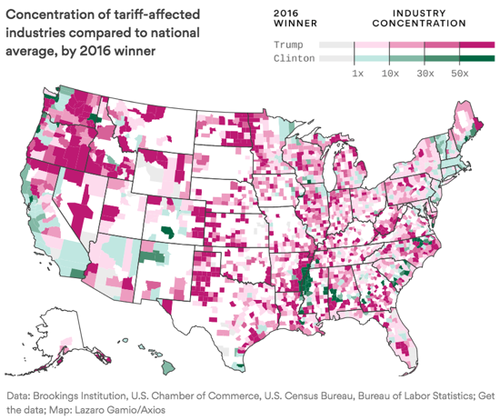President Trump’s trade war with China is expected to last much longer than initially thought — extending into the second half of 2019, experts state. The main reason: neither Washington nor Beijing want to appear politically weak at home, and both are prepared to absorb economic pain; furthermore, Trump is convinced he is winning the trade war and will keep pushing until he is forced to reverse by the stock market.
According to an Axios report, President Trump’s trade war could affect companies employing some 11 million blue-collar workers, as the threat of an imminent trade escalation could strike by the end of the week.
The chart below depicts companies affected by Trump’s dangerous trade policies are mostly concentrated in rural, deeply red, deindustrialized regions of the country, with political consequences for the Trump administration in 2018 and beyond. Axios said the map tracks the geographical impact of both current and threatened retaliation. The darker a region, the higher the concentration of affected industries there.

Tit-for-tat has become the norm for China, as both countries dig in for a deepening trade war that is already causing many experts to warn about a global slowdown. To date, Beijing has imposed a 25 percent tariffs on $50 billion of American products. It has also threatened to respond to the newest round of US tariffs with a proposed tax on $60 billion of US goods, by strategically targeting Trump’s base in rural America just in time for the US midterm elections.
As for the 11-million blue-collar workers, employment in rural, deindustrialized regions in the US can be exceptionally vulnerable to shifts in the global economy, said Mark Muro, a senior fellow at the Brookings Institution. “In a small county, a single meat packing establishment can provide hundreds of jobs and make up a large share of that county’s total employment.”
The question then is whether the pain threshold of those 11 million workers affected will be triggered and, more importantly, how they will vote in November.












Leave A Comment